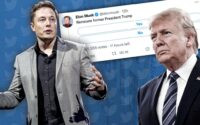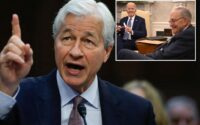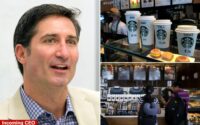Fed hikes interest rates to 22-year high after June pause
The Federal Reserve on Wednesday took its foot off the brakes and hiked interest rates yet again — taking them to a 22-year high.
Fed Chairman Jerome Powell announced the unanimous decision for a quarter-point hike, raising the benchmark federal-funds rate to a range between 5.25% and 5.5%.
It marked the 11th increase in the past 12 meetings following last month’s brief pause.
The hike sent the benchmark rate to its highest point since 2001 — and Powell signaled that another increase is possible before the year’s out as officials continue to wrestle with stubbornly-high inflation.
“The process of getting inflation back down to 2% has a long way to go,” Powell said at a press conference following the decision.
“We think we’re going to need to hold, certainly, policy at restrictive levels for some time, and we’d be prepared to raise further if we think that’s appropriate.”
Powell, who initially insisted that inflation was “transitory before it soared to a four-decade high, also proclaimed that Fed staff is no longer forecasting a recession.
“We do have a shot” for inflation to return to target without high levels of job losses, he said.

“So the staff now has a noticeable slowdown in growth starting later this year in the forecast, but given the resilience of the economy recently, they are no longer forecasting a recession,” he said.
Key measures of inflation remain more than double the Fed’s target, and the economy by many measures, including a low 3.6% unemployment rate, continues to outperform expectations given the rapid increase in interest rates.
Job gains remain “robust,” the Fed said, while it described the economy as growing at a “moderate” pace, a slight upgrade from the “modest” pace seen as of the June meeting. New data on Thursday is expected to report the economy grew at a 1.8% annual pace in the second quarter, according to economists polled by Reuters.
Powell ruled out the possibility of cutting the fed rate this year.
“We’ll be comfortable cutting rates when we’re comfortable cutting rates, and that won’t be this year,” he said.

Investors took the anticipated quarter-point hike in stride, pushing the Dow into the green for the 13th straight session — it’s best streak since 1987. The S&P 500 and the Nasdaq closed slightly down.
“The forward guidance remains unchanged as the committee leaves the door open to further rate hikes if inflation does not continue to trend lower,” said Kathy Bostjancic, chief economist at Nationwide. “Our view is the Fed is likely done with rate hikes for this cycle since continued easing of inflation will passively lead to tighter policy as the Fed holds the nominal fed funds rate steady into 2024.”
Despite the positive stock run, higher rates mean Americans are in for increased costs when it comes to borrowing funds to purchase homes and cars, which will likely dampen consumer spending.
The cost of credit cards may also remain high, making it more difficult for consumers to pay off their debt.
The average credit card interest rate in the US is currently 24.24%, according to LendingTree — the highest rate since the online loan marketplace began tracking average rates in 2019.
The latest figure is up from the average credit card interest rate of 16% in March 2022, just before the Fed started hiking rates.

Meanwhile, the Consumer Price Index — a closely-monitored measure of inflation that tracks changes in the costs of everyday goods and services — rose 3% in June versus a year earlier.
Last month’s advance was short of the 4% rise the CPI saw in May compared to the same month in 2022.
In June 2022, inflation peaked at 9.1%.
Policymakers are set to meet three more times by the end of this year, in September, November and December.


